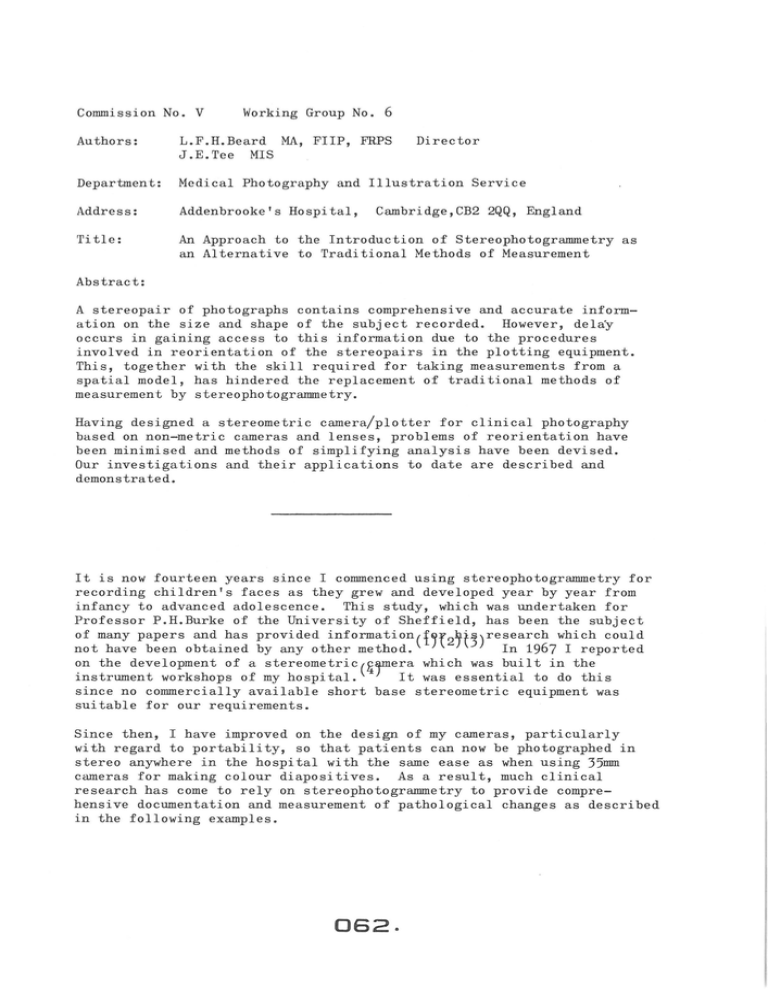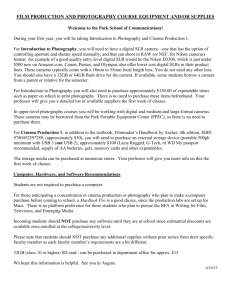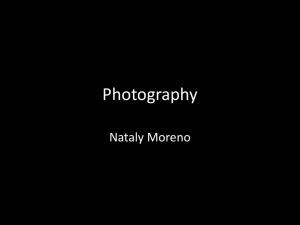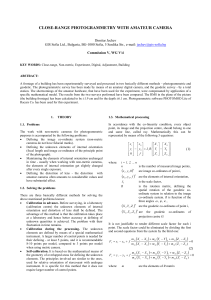6
advertisement

Commission No. V
Working Group No. 6
Director
Authors:
L.F.H.Beard MA, FliP, FRPS
J.E.Tee MIS
Department:
Medical Photography and Illustration Service
Address:
Addenbrooke's Hospital,
Title:
An Approach to the Introduction of Stereophotogrammetry a s
Cambridge,CB2 2QQ, England
an Alternative to Traditional Methods of Measurement
Abstract:
A stereopair of photographs contains comprehensive and accurate information on the size and shape of the subject recorded. However, delay
occurs in gaining access to this information due to the procedures
involved in reorientation of the stereopairs in the plotting equipment.
This, together with the skill requ ired for taking measurements from a
spatial model, has hindered the replacement of traditional methods of
measurement by stereophotogrammetry.
Having designed a stereometric camera/plotter for clinical photography
based on non-metric cameras and lenses, problems of reorientation have
been minimise d and methods of simplifying analysis have been devised.
Our investigations and their applications to date are described and
demonstrated.
It is now fourteen years since I commenced using stereophotogrammetry for
recording children's faces as they grew and developed year by year from
infancy to advanced adolescence. This study, which was undertaken for
Profe ssor P.H.Burke of the University of Sheffield, has been the subject
of many papers and has provided information(t~{ 2 Jt3)research which could
not have been obtained by any other method.
In 1967 I reported
on the development of a stereometric(~rruera which was built in the
instrument workshops of my hospital.
It was essential to do this
since no commercially available short base stereometric equipment was
suitable for our requirements.
Since then, I have improved on the design of my cameras, particularly
with regard to portability, so that patients can now be photographed in
stereo anywhere in the hospital with the same ease as when using 35mm
cameras fo r making colour diapositives. As a result, much clinical
research has come to rely on stereophotogrammetry to provide comprehensive documentation and measurement of pathological changes as described
in the following examples .
062.
Contour lnltr'wd. 2mm
Fip;ure 1
Pre and post. operative facial plots of patiPnt Rllfferinp; from
chronic renal failure showing changes due to irnmunosuppreHive therapy.
A clinical condition arises from the
receiving immunosuppresive therapy.
the areas of selected cross sections
conditions due to endocrine disease.
changes in renal transplant patients
The volume of the face together with
are compared with similar oedematous
(Figure 1)
Figure 2
P lots prepared 'for volumetric studiPs
of patients undergoing treatment for acromegaly .
Control of acromegaly by chemotherapy was confirmed in fi ve patients
receiving treatment and claims that the condition could actually be
reversed were substantiated. (Figure 2)
A new dressing used in the tr eatment of varicose ulcers was compared with
that currently in use and to this end only patients with bilateral ulcers
were chosen . The new dressing was applied to one ulcer while the established treatment was continued with the other. Information was sought
on the total area of each lesion together with the depth of erosion.
Colour film was chosen since it was necessary to differentiate clearly
063.
l'igure 3
Photo gr11phy of
v~tricose
ulcer.
Area defin<>rl by
dotted line shows reduction in size over 3 months but
increase in volume of leg due to UVT.
Contour interval 2mm.
between necrosis and healing and photographs were taken at monthly
intervals. Standard colour slides were also taken for simple visual
assessment on each occasion and these alone provided valuable information
on the stages of healing. Certain clear patterns emerged which may have
a long term influence on the treatment of this condition but a salutary
lesson was to given to those who doubted the validity of stereophotogrammetry. Ulcers showing significant changes were chosen for detailed
analysis. The plots shown in Figure 3 revealed the anticipated change
in shape and diminution of the lesion but the volume of the leg had
increased. The accuracy of the measurements was at first questioned but,
on further examination, the patient was found to have developed a deep
vein thrombosis. Subsequent studies confirmed the continued regression
of the ulcer with the leg having reverted to its normal size. It is
unforeseen episodes such as this that give biostereometrics the recognition it merits.
It is, therefore, somewhat surprising, not to say disappointing, to find
that stereophotogrammetry has not, as yet, replaced the conventional
approach to routine clinical measurement. A recent survey into this
showed considerable lack of precision in some of the instruments in use
and in the methods employed in using them. These included string, tape
measure, ruler, calipers, goniometer, exophthalmometer, contour frame
or just estimates by eye recorded by memory. The general impression was
of a rather casual approach to the whole subject. This was highlighted
by the fact that we were repeatedly assured that the accuracy which we
claimed for stereophotogrammetry was not relevant to the needs of the
clinician.
We, therefore, decided to examine the criticisms and shortcomings of
stereophotogrammetry as compared with other measuring instruments and
to overcome these as far as possible. We should then be able to highlight its advantages with a view to surmounting the inevitable prejudice
with which the medical profession greets any innovation .
The following disciplines, active in the field of measurement, were
chos en for this approach:
Dermatology, Endocrinology, Geriatrics, Ophthalmology, Orthodontics,
Orthopaedics, Paediatrics and Respiratory Physiology.
The advantages of stereophotogrammetry are listed as follows:
i)
the recording of the stereopair of photographs puts the patient to
no more inconvenience than routine clinical photography;
ii)
there is no physical contact with the patient therefore there is no
risk of hurting or infecting the patient in any way;
iii)
soft tissue areas are not distorted and inaccessible regions, such
as the eye or internal anatomy exposed during surgery, are as
readily recorded as surface detail;
iv)
v)
the results are available for simple visual assessment and comparison
with serial records thus providing valuable permanent documentation;
the stereopairs yield measurements to an accuracy of 0.5mm and the
information may be provided in the form of contour maps, volumes,
surface areas, cross sections or simple measurements from point
to point.
In order to substantiate our claim to be able to provide all these
facilities, we had first to reduce the cost of our cameras and then to
eliminate the need for sending our stereopairs away, except for detailed
analysis and plotting, since this introduced an unacceptable delay and
was a service for which we would have to pay.
Professor Karara, in his keynote address to the symposium on Biostereometrics held in Washington in 197~, made reference t3)the use of nonmetric cameras in close range stereophotogrammetry.
His findings
showed that the accuracies obtained were completely acceptable in the
biomedical fields. Thus encouraged, we have now designed a stereometric
camera using standard 35mm cameras which require no modification other
than the fitting of glass stage plates in the focal plane to ensure film
flatness. For our work, lenses with a focal length of 28mm are used.
The cameras are rigidly mounted on a metal frame having a base length of
1~0mm and height of 350mm.
Wires, intersecting at the principal points,
are attached to the frame for reorientation purposes.
Analysis of the stereopairs, which take the form of 35mm diapositives in
colour, is carried out by projecting these through the cameras. Lamp
houses were specially designed and constructed to replace the camera
backs, the film being held in contact with the stage plates by spring
loaded optical flats. A point source of light is focused through a
simple condenser system so that the image of the filament lies in the
optical centre of the lens and comes to a focus in the plane of the
diaphragm, fulfilling the same conditions as in Multiplex plotters. The
camera fits on to a plotting table thus forming an integrated unit. This
consists of a horizontal screen which may be raised and lowered, its
height, corresponding to the z co-ordinate, being read in digital form
from a LED display or entered directly into a microcomputer. Similarly,
the x and y co-ordinates of any spot height may be recorded on graph
paper together with the z co-ordinate or the graph paper may be replaced
by a digitising tablet to provide the appropriate data input for the
computer so that any desired display or calculation may be acquired
quickly and accurately.
065.
Initially, the data from our stereopairs were derived from maps made at
a contour interval of 2mm. However, experience has shown that the
distances between predetermined points, which may be anatomical landmarks
or marks made on the skin, were in many cases all that were required.
Where profiles were needed to reveal changes in the subject due to
growth or disease, these have been derived simply by recording only
the co-ordinates which lay along the relevant section of the stereomodel.
...
..,,..
.....,
.,.
.,.
...... ...
......
•I•
......
.,.
..,.,.
..,...,.,.
•I•
.,.
."
..,...
....,.
......
Figure
~
Examples of patterns projected
to
produce reference points
In order to remove complete dependancy on the ability to observe a
three dimensional image, we have sought means of introducing clearly
visible reference points on the subject in the absence of suitable
anatomical ·landmarks or skin impurities. The most successful of these
has proved to be the projection of points on to the surface of the skin
through the primary light source. Points in a random pattern were
difficult to identify with confidence and so we designed arrays for
specific purposes. (Figure q)
Figure 5 The effect of projecting lines radiating
from the perspective centre of the projection lens
066.
Lines radiating from one point, if arranged so that their origin is
from the perspective centre of the projection lens, may be deemed to be
devoid of lateral displacement and undistorted by variations in magnification due to the depth of the subject. Thus, the deviation along
any line, to be seen in the diapositives from left and right cameras, is
due solely to the variation in contour of the subject.(Figure 5) When
these lines are brought into coincidence on projection, the points whe~e
they merge lie along a single axis and a continuous string of co-ordinates
may be recorded. The measurements which it is possible to make from
stereopairs enhanced in this way range from the x,y,z co-ordinates of
spot heights, through linear distances between two points and profiles
along a specified axis to surface areas and volumes.
We thus have four distinct means of obtaining measurements depending on
the complexity of the results required.
i)
ii)
The co-ordinates of clearly defined anatomical landmarks or skin
impurities can be measured directly from the stereopair, yielding
spot heights and linear distances;
in the absence of points of reference, marks may be made on the
skin, the patient being requested to renew these if serial
measurements are to be made;
iii)
when profiling is also required, a radial grid pattern is projected on to the subject, this pattern being capable of yielding
estimates of surface area and volume as well;
iv)
it is only when extremely detailed information on the subject is
required that it is necessary to plot the image stereoscopically
in order to produce contour maps.
It has been possible to design a camera with plotting facilities which
is relatively inexpensive while yielding results of sufficient accuracy
to assess the progress of the disease under investigation. Measurements
can be made rapidly without the aid of a skilled technician. However,
should more detailed information be required, corrected diapositives,
produced by projection through the camera lenses, may be used in standard
plotting equipment for producing contour maps. We are not questioning
the undoubted excellence of pure stereophotogrammetry but merely
simplifying the procedures and speeding up analysis when limited information is required.
Digitising the output from the camera and linking this to a microcomputer
greatly facilitates the analysis of the data. It removes the restriction
on the number of co-ordinates to be read and ensures an uninterrupted
observation of the stereomodel during analysis, allowing a rapid compilation of areas and volumes. The plotting of profiles can be carried
out instantaneously, viewed on a visual display unit and, if needed,
printed out as hard copy.
While recording the subject of interest, the surrounding area is also
photographed. Thus, if changes there become significant, these too
can be measured.
067.
Finally, I would like to say that there is little doubt that, when the
convenience and validity of stereophotogrammetry are no longer in question,
the accuracy, so often rejected, will come to be appreciated when it is
realised that for the first time minute changes can be observed. In this
way, it may be compared with high speed and time lapse photography which
have enabled events which occur too rapidly or too slowly for the eye to
perceive to be observed in detail.
References:
1
2
3
Burke, P.H. and Beard, L.F.H., Stereophotogrammetry of the Face,
Amer. Jour. Orthodontics, Vol. 53, No. 10, pp 769-782. 1967
Burke, P.H., Beard, L.F.H. and Tee, J.E., Biostereometric Analysis
of Serial Growth Changes of the Lips, Applications of Human Biostereometrics, Paris 1978
Burke, P.H., Growth of the Soft Tissues of the Middle Third of the
Face between 9 and 16 Years, Eur. Jour. Orthodontics, Vol. 1, p:P 1-13.
1979
4
5
Beard, L.F.H., Three-Dimensional Contour Mapping by Photography,
Phot. Jour., Vol. 107, No. 10, pp 315-323. 1967
Karara, H.M., Photogrammetric Systems for Biomedical Applications,
Biostereometrics '74, pp 1-26.
068.






